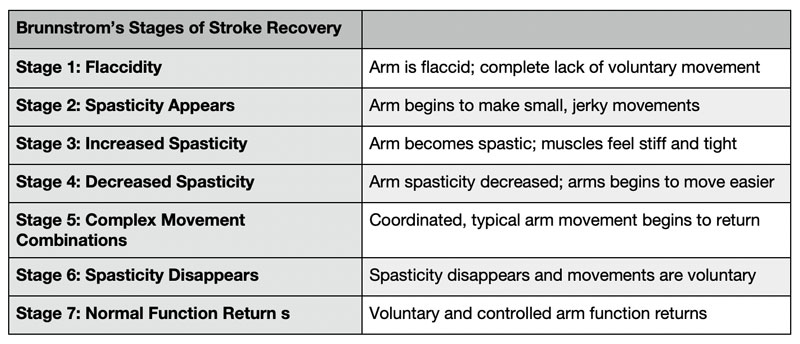25 Jun Arm Weakness & Stroke Recovery
Experiencing a Cerebrovascular Accident (CVA), commonly known as a “stroke,” is a scary event that often leaves people shocked and in dismay. In the United States, stroke is the 6th leading cause for disability. Side effects of a stroke can include changes with thinking, speaking, arm weakness, and difficulty with sitting and/or walking.
“As an Occupational Therapist, I am often asked how I can help a person with arm weakness after a stroke,” states Jennica Colvin, Occupational Therapist and Owner of Trio Rehab. “Knowing that 75% of stroke survivors will have impaired arm and hand, I take that question seriously.”
The first key to stroke recovery is education!
Using Brunnstrom’s stroke recovery theory of motor return in the arm after a stroke, you can see that recovery is NOT static. As your body and brain heal, your motor functions should also improve.

If there is a component of spontaneous recovery, then what is the reason for seeking the support of an Occupational Therapist in the rehabilitative process? The first reason for engaging in occupational therapy is to promote functional use of the arm affected by the stroke. When a stroke occurs and a person’s arm is left paralyzed, a behavior pattern of not using the arm emerges. This is known as “learned non-use.” The old adage is true, use it or lose it.
Why Occupational Therapy for Stroke Recovery?
After a stroke when there’s no voluntary motion or extreme weakness in the arm is when an Occupational Therapist can be especially helpful. The role of therapy is to ensure the shoulder blade, arm, wrist, and hand remain mobile, and to help prevent pain, decrease the risk of skin breakdown, and encourage the patient to use their non-affected hand to stretch and move the affected limb.
As the recovery enters into stage 3, stretches and other manual therapy may be needed to decrease the tight muscle feeling. An orthotic device may be required to wear during the day or night to prevent the hand from becoming stiff and contracted.

Secondly, as motor and even sensory function return to the affected arm, the motion may feel awkward and weak. This awkward and weak mobility often leads to bad habits such as hiking the shoulder to raise the arm overhead or not extending the elbow to reach forward. An experienced Occupational Therapists, trained in stroke rehabilitation, can anticipate potential bad habits and prevent them by providing verbal, visual, and tactile cues to facilitate the correct movement. Re-learning a motor activity correctly can prevent pain, continued spasticity, and improve independent performance of daily activities such as getting dressed and bathing.
Finally, occupational therapy, focused on stroke recovery, will help to promote new motor learning. The human brain is a marvelous thing. Even after an event such as a stroke, it can relearn how to communicate with the shoulder, arm, and hand by forming new motor pathways. However, intense ‘forced use’ of the affected arm is required, as well as focused practice of what motivates the patient.
“The best therapy outcome occurs when patients engage in motor activities they love, such as painting and drawing, vs performing repetitive and often non-stimulating (a.k.a. boring) arm exercises,” offered Colvin. “Don’t get me wrong; exercises to address arm weakness are needed, but they are a small part of the therapeutic process.’’
The essence of occupational therapy is to promote participation in life, including daily activities such as eating, grooming, and dressing. In addition, the role of an Occupational Therapist is to increase the independent performance of driving, financial management, and meal preparation. All of these tasks can be severely debilitated after a stroke. Occupational therapy, focused on stroke recovery, can help regain the motor use of a weak arm, improve the strength and endurance of the arm, and help return the patient to normal performance of daily tasks and, ultimately, the greatest amount of independence possible.
For more information about occupational therapy after a stroke, read the “Simplified Guide to Occupational Therapy After Stroke,” by Saebo, a medical device company.

